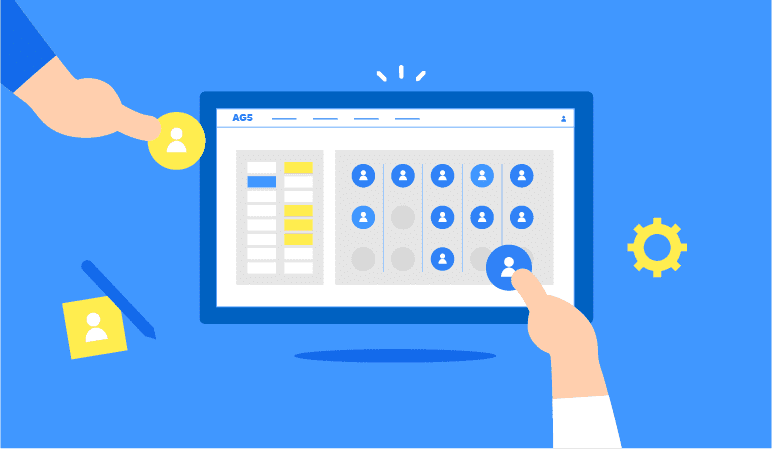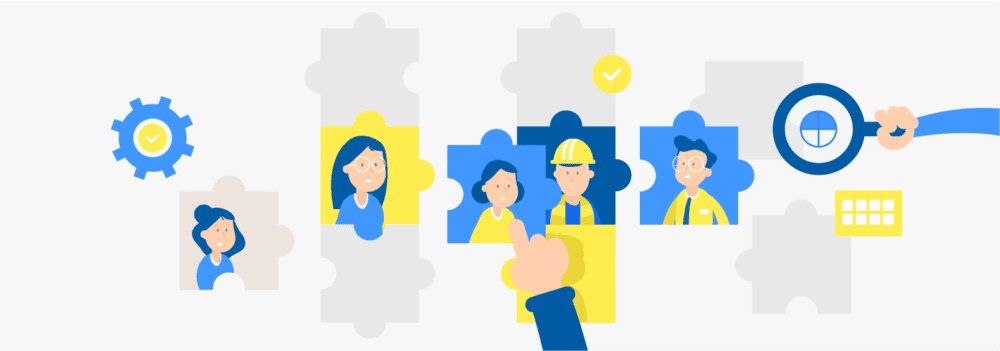7 tips for more effective staff planning
Staff planning is essentially an overview of who works where and when. In smaller companies, this isn’t that big an issue. But as your workforce grows, it’s worth optimizing your staff planning processes. This article shares our top tips. But what is staff planning? Staff planning involves managing your workforce’s capacity and time as effectively as possible. The aim is...


Staff planning is essentially an overview of who works where and when. In smaller companies, this isn’t that big an issue. But as your workforce grows, it’s worth optimizing your staff planning processes. This article shares our top tips.
But what is staff planning?Copied
Staff planning involves managing your workforce’s capacity and time as effectively as possible. The aim is to assign the right employees with the right skills to the right jobs. But striking a balance between staffing supply and demand is a tricky juggling act.
Types of staff planningCopied
We’ve identified three main types of staff planning:
1. Operational staff planning
This relates to the short term and is probably the type of staff planning most people are familiar with – scheduling, generating, evaluating, and adjusting actual shifts and staffing levels.
2. Strategic staff planning
This focuses more on optimizing your organization’s staffing levels for the future – mapping where you want to be in several years’ time and what skills you’ll need to get there. Based on this information, you can then make strategic decisions about the inflow and outflow of your employees, the directions your departments should take, and the way you plan in general.
3. Tactical staff planning
This focuses more on the short-to-middle term – calculating the outcomes of various scenarios and eventualities based on variables such as vacation, leave, absenteeism, peaks & troughs, current skill levels, training, etc. This paints a clearer picture about any shortages or surpluses that might prompt you to adjust your staff planning.

Tips for more effective staff planningCopied
Optimizing your staff planning is often a complex puzzle. But following these tips can help you put the pieces together a little bit more quickly:
1. Work in the cloud
Working in the cloud has so many benefits for creating and maintaining your staff planning, for example it means it’s available anytime, anyplace, anywhere. Everyone from boardroom to shop floor can access it and, if need be, adjust it accordingly.
What’s more, version management becomes a thing of the past because you no longer need to deal with the headache of multiple versions of Excel spreadsheets being passed around. You’ll be certain that everyone has the latest version on the screen in front of them.
2. Schedule flexibly
There’s always something that can throw a wrench in the works, for example employees who need to swap shifts or somebody who’s turned up late to work. Other times, clients can throw you a curveball, for example a last-minute order or even an order cancellation.
Keep such eventualities in mind when making your plans, for example by creating a contingency plan or keeping a pool of replacements and extras on standby.
3. Plan well in advance
It’s important to make your plans well in advance. Once you’ve received information about your staff’s availability, don’t wait too long to create their schedules. The longer you wait, the more can change. And make sure everyone gets the schedule in plenty of time. But don’t plan too early either, and certainly not before you’ve received everyone’s availability information.
4. Communicate clearly
Clearly explain why you’ve assigned staff to a given shift, as this can help minimize irritation and pushback. This is another reason to ask your staff to inform you about their availability in advance. If you do so, do your best to actually take this into consideration. For example, if you employ students and parents, make a note of when they have lectures, exams, school pick-ups, etc.
What’s more, if you take your staff’s professional and personal preferences into account, too, you’ll most likely be rewarded with even greater productivity and satisfaction levels.
5. Analyze & optimize
If you’re about to set up a new work schedule, it’s wise to take a look at the past few months. What worked well? What went wrong? Who kept wanting to swap shifts? Did they have good or legitimate reasons for doing so? Was it a one-off incident or a regular occurrence? Pinpoint the bottlenecks and anticipate similar issues for the upcoming months. Planning tools are great for analyzing these challenges and taking appropriate action.
6. Use skills matrices
Skills matrices are great tools for optimizing your staff planning. By mapping your staff’s skills and competences in a matrix, you can see at a glance who can do what and who can’t.
They’re made up of a series of rows and columns. List your employees’ names down the left-hand column and all the skills needed to perform a certain task along the top row (or vice versa). Armed with this visual information, it’s a piece of cake assigning the right person to the right job at the right time.
Read our article, ‘Everything you need to know about skills matrices’, to find out more.
7. Or even better, use skills management software!
Chances are that after a while you’ll want to take your staff planning to the next level. In which case, you’ll be better off with special-purpose skills management software, as this will provide you with a whole spectrum of new possibilities.
- display all the information about your staff’s skills and competences at a single glance – all stored centrally in the cloud
- update your skills matrices from the shop floor in real time
- suppose someone calls in sick at the last moment – no sweat – just open up the software and find the most suitable replacement with a tap of the screen or a click of your mouse
- list the extra staff you can call on to pick up the extra workload – quickly and easily – whenever a busy period is looming
Read our article, ‘Everything you need to know about skills matrices’, to find out more.
Scheduling becomes a breeze!Copied
Staff planning might seem like a huge task at first glance, but by arming yourself with the right tools and the right information and communicating clearly you’ll find it’s not as bad as you thought.
Schedule a free online demo – no strings attached – to find out how AG5’s software could help your organization with its staff planning.
